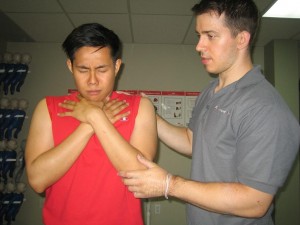There are plenty of first aid myths about how to administer. However, some of

these myths can cause more damage rather than helping the victim. Thus, it is necessary to debunk these first aid myths. Learn proper first aid administration by enrolling in First Aid Classes and CPR Courses. The following are the common first aid myths and the truth behind these myths:
Myth 1: If someone is having a heart attack, they should lie down.
Lying down will make it harder for the victim to breathe. It is more advisable to be in a half-seated position with knees bent and a supported back. If necessary, perform CPR on a flat, rigid surface.
Myth 2: If someone is feeling faint, put their heads between their legs.
This position could cause an individual to fall forwards and cause further injury to self. Sitting up would also could also cause the same reaction. Instead, advise them to lie down and elevate their legs to increase blood flow to the brain.
Myth 3: If someone is having a seizure, put something inside the mouth to prevent individuals from biting or swallowing tongue.
By putting something inside the mouth, this could break the teeth or the object and instead cause choking. Instead of this, put an object beneath the head to serve as a cushion, such as a coat or blanket. Remove any nearby hazards.
Myth 4: If someone is choking, attempt to remove the object using the fingers.
Attempting to remove the object using the fingers may actually push the object deeper into the throat. One may better opt to smack the person between the shoulder blades and if does not work, perform the Heimlich manoeuvre.
Myth 5: If someone is hyperventilating, make them breathe into a paper bag.
Doing this can cause dangerously low levels of oxygen. Rather than breathing into a paper bag, advice the person to breathe slowly and deeply until they relax. It is also recommended to drink sips of water.
Myth 6: If a person gets a snake bite, suck the venom out.
This does not help, nor does cutting. Instead, call for emergency medical services immediately and do not leave the bitten individual alone. Keep the bitten area below heart level and wash the bite with warm water and soap.
Myth 7: If a person gets stung by a jellyfish, put urine on it.
This will only work if the urine is acidic and since one is not always sure of the acidity, opt to put vinegar.
Myth 8: If a person gets a nosebleed, lean back.
Leaning back will cause the person to swallow blood, which, in turn, will irritate the stomach and might cause vomiting. Instead, pinch the nostrils together for 15 minutes and tilt the head forward.
Myth 9: If a person is feeling cold, drink alcohol to warm the victim.
Alcohol will make an individual feel flushed and warm, however, drinking alcohol may actually lead to hypothermia in the cold weather. Gradually warm the extremities by soaking it in lukewarm water.
Myth 10: Do nothing. Doing something can just make things worse.
People often feel that they will cause more harm than help. Although one cannot perform medical procedures, there are certain simple actions that can help save a life. This is the purpose of first aid, for the both the medical and non-medical members of society to perform life-saving techniques that can prevent damage from getting worse while waiting for medical assistance. This is why first aid training is highly recommended for all.
Most of these first aid myths have probably already been heard of or even practiced. Not following proper protocol for first aid may lead to worsening damage and even cost a life. Debunking and correcting first aid myths can be learned by enrolling in First Aid Courses.
http://youtu.be/1XXjd6v11Qo
Online Sources:
http://www.health24.com/Medical/First-aid/About-first-aid/10-first-aid-myths-20130210
http://firstaid.about.com/od/firstaidbasics/tp/06_bad1staid.htm
